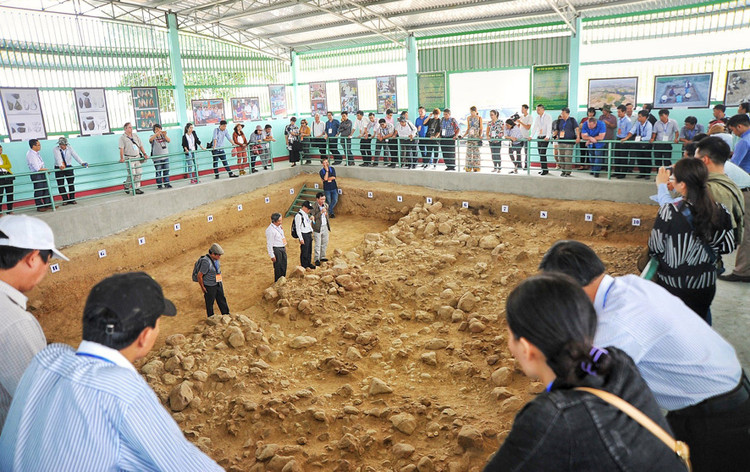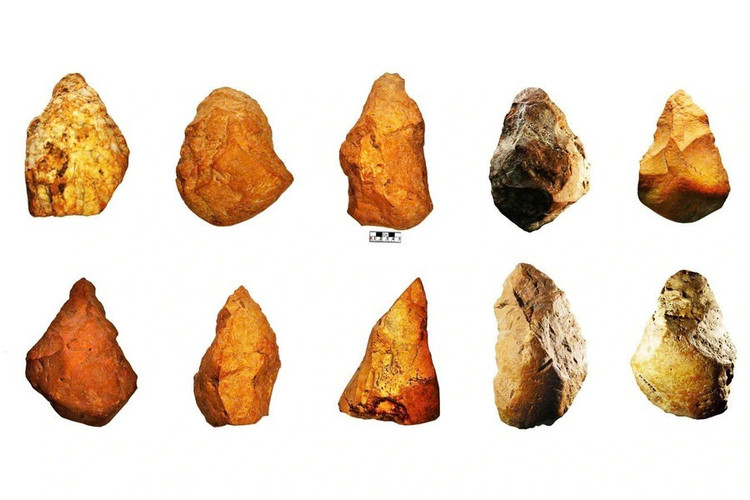On August 13, Ms. Do Thi Dieu Hanh, Director of the Department of Culture, Sports and Tourism of Gia Lai province, said that she is coordinating with relevant departments to prepare a dossier to submit to the Provincial People's Committee to request the United Nations Educational , Scientific and Cultural Organization (UNESCO) to recognize the Roc Tung - Go Da archaeological complex as a world heritage site.
The Roc Tung - Go Da relic was first discovered in 2014. Many stone artifacts, stratigraphy, relics and analysis results of meteorite fragments discovered here have confirmed that an ancient community of residents and the first cultural achievements of mankind existed in the area 800,000 years ago.
Precious vestiges of primitive human habitation
According to the documents of the Department of Cultural Heritage, the Roc Tung - Go Da Early Stone Age relic complex includes Go Da relic in An Binh ward and 12 Roc Tung relics in Xuan An commune, An Khe town (old), Gia Lai province. The Old Stone Age archaeological relics in An Khe are distributed on hills with an average height of 420 - 450m above sea level, in the transitional area from the plateau to the coastal plain of Central Vietnam. The terrain here is quite flat, in the form of an ancient Ba River valley with a rich and diverse flora and fauna and an abundant source of cobblestone, suitable for prehistoric people to reside for a long time.
The relics are preserved in a stratum with an average thickness of 25cm - 40cm, located under the cultivated soil layer and above the granite soil layer. They are the product of in situ weathering of granite, lateritized, with a solid bond. Among them, human labor tools and fragments of meteorites that fell from extraterrestrials were found. The stratum containing traces of human culture in An Khe is quite intact.

The assemblage of artifacts in the An Khe Paleolithic relics has a unity and stability in terms of materials, types, and manufacturing techniques, bearing the common characteristics of an early Paleolithic industry, called the An Khe industry. The An Khe industry is characterized by a set of stone tools made from local river and stream pebbles, large in size, hard, fine-grained stone, mainly quartz and quartzite. The stone tools were roughly chiseled with typical types: beface tools, handaxes, picks, triangular points, and choppers.
Based on the ratio of complete tools and recorded raw stones, the Go Da and Roc Tung 1 sites preserve more distinct traces of habitation, while the Roc Tung 4 and Roc Tung 7 sites have more typical workshop elements. Other sites explored show that they were both habitation and tool making sites, reflecting the nature of the An Khe Paleolithic sites and many other places in the world.
Based on stratigraphic data and radioactive isotope dating from relics, Vietnamese and Russian archaeologists determined that the An Khe Paleolithic archaeological site dates back to the early Paleolithic period.
In terms of geological data, the An Khe archaeological sites are located on the oldest terrace of the Ba River, which is of early Canh Tan age (QI3), 2.7 million to 1 million years ago. This can be considered the previous limit of the An Khe sites. The stratum containing An Khe stone tools is originally weathered from granite, a layer of early Canh Tan age.
In the excavation pits, over 300 meteorite fragments were found lying with stone tools in intact strata.
World-class site
When comparing the tool typology between An Khe and other known early Paleolithic industries in Vietnam such as Nui Do (Thanh Hoa) which is 0.4 million years old and Xuan Loc (Dong Nai) which is 0.6 million years old, archaeologists believe that An Khe industry is different and older than the above two industries.
So far, no human remains have been found in the An Khe Paleolithic sites. This is also the general situation of Paleolithic sites in the world. In some sites dating from 1 million to 0.5 million years old, fossils of Homo erectus are often found.

Thus, the master of the An Khe industry was Homo erectus. This type of human was also found in Tham Khuyen and Tham Hai (Lang Son province). But there, no stone tools were found. In An Khe, earlier, tools were found but no human remains were found.
The appearance of biface tools in Southeast Asia and South China is not related to the invasion of Acheulean people into this territory. Therefore, the owners of the early Paleolithic industries in Vietnam are the result of convergence or contact with other early handaxe users on the old continent. The appearance of handaxes in An Khe reflects the compatibility of people with the environment, the simultaneous and independent development between different regions.
During the excavation, a large number of relics were recovered, including a number of important relics, indicative of the nature, age and exceptional value of the site. These are two-sided hammering tools / hand axes, triangular and triangular points, unifaced hammering tools, rough chopping tools, scraping tools, and tektites.
In the world, hand axes in the Acheulean industry (in France) are considered by scientists as typical tools for the early Paleolithic industry of mankind. They are made of flint, hammered on both sides, have a thin pointed blade, a wide and thick handle, and come in many shapes, but the most typical is the spearhead. Along with the hand axes are also Moustier points; Clacton flakes, Levallois nodules, and bolas, dating back 0.5 million years ago. To date, Acheulean hand axes have been found in many early Paleolithic relics in Europe, Africa, and Asia, dating from 1.7 million to 300,000 years ago.
With the above typical values, Roc Tung - Go Da relic was ranked as a National Monument in 2020. By 2023, this site will be upgraded to a Special National Monument.
Source: https://khoahocdoisong.vn/di-tich-800000-nam-roc-tung-go-da-cho-unesco-vinh-danh-post2149047243.html




























![[Photo] Politburo works with Standing Committees of Lang Son and Bac Ninh Provincial Party Committees](https://vstatic.vietnam.vn/vietnam/resource/IMAGE/2025/8/20/0666629afb39421d8e1bd8922a0537e6)

![[Photo] An Phu intersection project connecting Ho Chi Minh City-Long Thanh-Dau Giay expressway behind schedule](https://vstatic.vietnam.vn/vietnam/resource/IMAGE/2025/8/21/1ad80e9dd8944150bb72e6c49ecc7e08)
![[Photo] Prime Minister Pham Minh Chinh receives Australian Foreign Minister Penny Wong](https://vstatic.vietnam.vn/vietnam/resource/IMAGE/2025/8/20/f5d413a946444bd2be288d6b700afc33)








































































Comment (0)